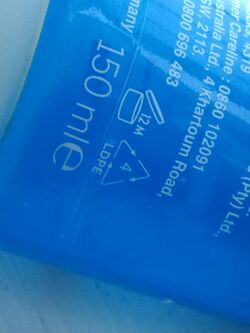Chemistry:Low-density polyethylene

Low-density polyethylene (LDPE) is a thermoplastic made from the monomer ethylene. It was the first grade of polyethylene, produced in 1933 by Dr John C. Swallow and M.W Perrin who were working for Imperial Chemical Industries (ICI) using a high pressure process via free radical polymerization.[1] Its manufacture employs the same method today. The EPA estimates 5.7% of LDPE (resin identification code 4) is recycled in the United States.[2] Despite competition from more modern polymers, LDPE continues to be an important plastic grade. In 2013 the worldwide LDPE market reached a volume of about US$33 billion.[3]
Despite its designation with the recycling symbol, it cannot be as commonly recycled as No. 1 (polyethylene terephthalate) or 2 plastics (high-density polyethylene).[4][5]
Properties
LDPE is defined by a density range of 917–930 kg/m3.[6] At room temperature it is not reactive, except to strong oxidizers; some solvents cause it to swell. It can withstand temperatures of 65 °C (149 °F) continuously[6] and 90 °C (194 °F) for a short time. Made in translucent and opaque variations, it is quite flexible and tough.
LDPE has more branching (on about 2% of the carbon atoms) than HDPE, so its intermolecular forces (instantaneous-dipole induced-dipole attraction) are weaker, its tensile strength is lower, and its resilience is higher. The side branches mean that its molecules are less tightly packed and less crystalline, and therefore its density is lower.
When exposed to consistent sunlight, the plastic produces significant amounts of two greenhouse gases: methane and ethylene. Because of its lower density (high branching), it breaks down more easily than other plastics; as this happens, the surface area increases. Production of these trace gases from virgin plastics increases with surface area and with time, so that LDPE emits greenhouse gases at a more unsustainable rate than other plastics. In a test at the end of 212 days' incubation, emissions recorded were 5.8 nmol g-1 d-1 of methane, 14.5 nmol g−1 d−1 of ethylene, 3.9 nmol g−1 d−1 of ethane, and 9.7 nmol g−1 d−1 of propylene. When incubated in air, LDPE emits methane and ethylene at rates about 2 times and about 76 times, respectively, more than in water.[7]
The standard method to test plastic density is ISO 1183 part 2 (gradient columns), alternatively ISO 1183 part 1 (MVS2PRO density analyzer).[8]
Chemical resistance
- Excellent resistance (no attack/no chemical reaction) to dilute and concentrated acids, alcohols, bases, and esters
- Good resistance (minor attack/very low chemical reactivity) to aldehydes, ketones, and vegetable oils
- Limited resistance (moderate attack/significant chemical reaction, suitable for short-term use only) to aliphatic and aromatic hydrocarbons, mineral oils, and oxidizing agents
- Poor resistance, and not recommended for use with halogenated hydrocarbons.[9][10]
Applications
Polyolefins (LDPE, HDPE, PP) are a major type of thermoplastic.[11] LDPE is widely used for manufacturing various containers, dispensing bottles, wash bottles, tubing, plastic parts for computer components, and various molded laboratory equipment. Its most common use is in plastic bags. Other products made from it include:
- Trays and general purpose containers
- Corrosion-resistant work surfaces
- Parts that need to be weldable and machinable
- Parts that require flexibility, for which it serves very well
- Very soft and pliable parts such as snap-on lids
- Six-pack rings
- Juice and milk cartons are made of liquid packaging board, a laminate of paperboard and LDPE (as the waterproof inner and outer layer), and often with of a layer of aluminum foil (thus becoming aseptic packaging).[12][13]
- Packaging for computer hardware, such as hard disk drives, screen cards, and optical disc drives
- Playground slides
- Plastic wraps
- Plastic bags
- Plastic containers
- Pipes
- Housewares
- Battery cases
- Automotive parts
- Electrical components[11]
See also
- Film blowing machine
- High-density polyethylene (HDPE)
- Linear low-density polyethylene (LLDPE)
- Medium-density polyethylene (MDPE)
- Polyethylene terephthalate (PET/PETE)
- Stretch wrap
- Ultra-high-molecular-weight polyethylene (UHMWPE)
References
- ↑ Dennis Malpass (2010). Introduction to Industrial Polyethylene: Properties, Catalysts, and Processes. John Wiley and Sons. pp. 1–. ISBN 978-0-470-62598-9. https://books.google.com/books?id=-7cWD7MrtfEC&pg=PA1.
- ↑ "Municipal Solid Waste Generation,n word and Disposal in the United States". EPA.gov. 15 November 2016. http://www.epa.gov/osw/nonhaz/municipal/pubs/2010_MSW_Tables_and_Figures_508.pdf.
- ↑ "Market Study: Polyethylene LDPE (2nd edition)". Ceresana. http://www.ceresana.com/en/market-studies/plastics/polyethylene-ldpe/.
- ↑ Brady, Angela (28 December 2018). "How to Recycle Number 4 Plastic". San Francisco Chronicle. https://homeguides.sfgate.com/recycle-number-4-plastic-79124.html.
- ↑ "Exactly What Every Plastic Recycling Symbol Really Means". Good Housekeeping. 18 February 2022. https://www.goodhousekeeping.com/home/g804/recycling-symbols-plastics-460321/.
- ↑ 6.0 6.1 BPF. "Polyethylene (Low Density) LDPE, LLDPE" (in en). http://www.bpf.co.uk/plastipedia/polymers/LDPE.aspx.
- ↑ Karl, David M.; Wilson, Samuel T.; Ferrón, Sara; Royer, Sarah-Jeanne (1 August 2018). "Production of methane and ethylene from plastic in the environment" (in en). PLOS ONE 13 (8): e0200574. doi:10.1371/journal.pone.0200574. ISSN 1932-6203. PMID 30067755. Bibcode: 2018PLoSO..1300574R.
 This article incorporates text by Royer et al available under the CC BY 4.0 license.
This article incorporates text by Royer et al available under the CC BY 4.0 license.
- ↑ "FAQ". https://www.plastic-density.com/faq.
- ↑ Qiu, Xia-Wen; Pei, Jie; Wu, Chen-Chou; Song, Lin; Bao, Lian-Jun; Zeng, Eddy Y. (August 2021). "Determination of low-density polyethylene–water partition coefficients for novel halogenated flame retardants with the large volume model and co-solvent model". Chemosphere 277: 130235. doi:10.1016/j.chemosphere.2021.130235. PMID 33794435. Bibcode: 2021Chmsp.277m0235Q.
- ↑ "LDPE Chemical Compatibility Chart". CP Lab Safety. http://www.calpaclab.com/ldpe-chemical-compatibility-chart/.
- ↑ 11.0 11.1 Achilias, D.S.; Roupakias, C.; Megalokonomos, P.; Lappas, A.A.; Antonakou, Ε.V. (November 2007). "Chemical recycling of plastic wastes made from polyethylene (LDPE and HDPE) and polypropylene (PP)". Journal of Hazardous Materials 149 (3): 536–542. doi:10.1016/j.jhazmat.2007.06.076. PMID 17681427.
- ↑ LDPE products and applications. Exxon Mobil Corporation
- ↑ DOW LDPE 5004I. IDES – The Plastics Web
External links
- 2010_MSW_Tables_and_Figures_508.pdf. epa.gov
 |






